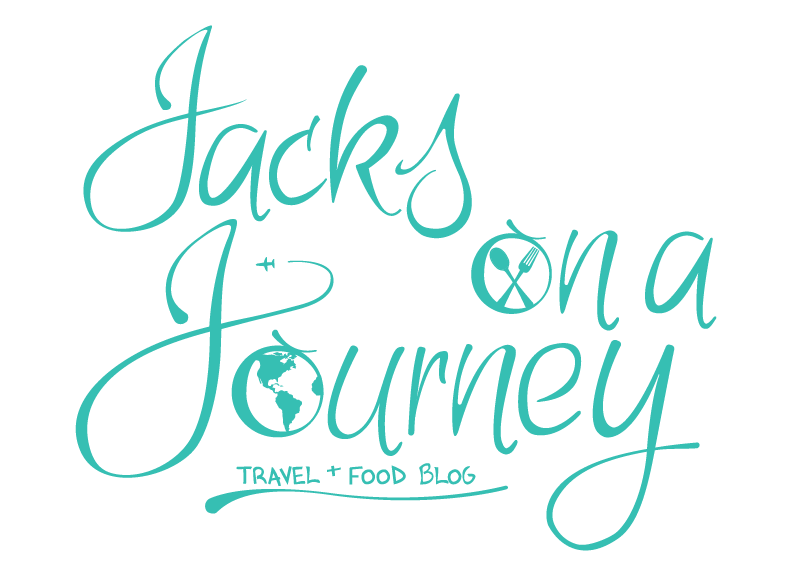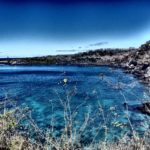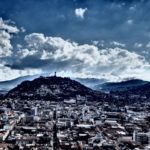Cartagena; our first stop in Colombia and the continent of South America! Sun, sea, history and a great introduction to the local culture were what we discovered here!
Located on the northern Caribbean coast of the country, this beautiful city has so much to offer travellers, which is why we have put together this backpackers guide to Cartagena.
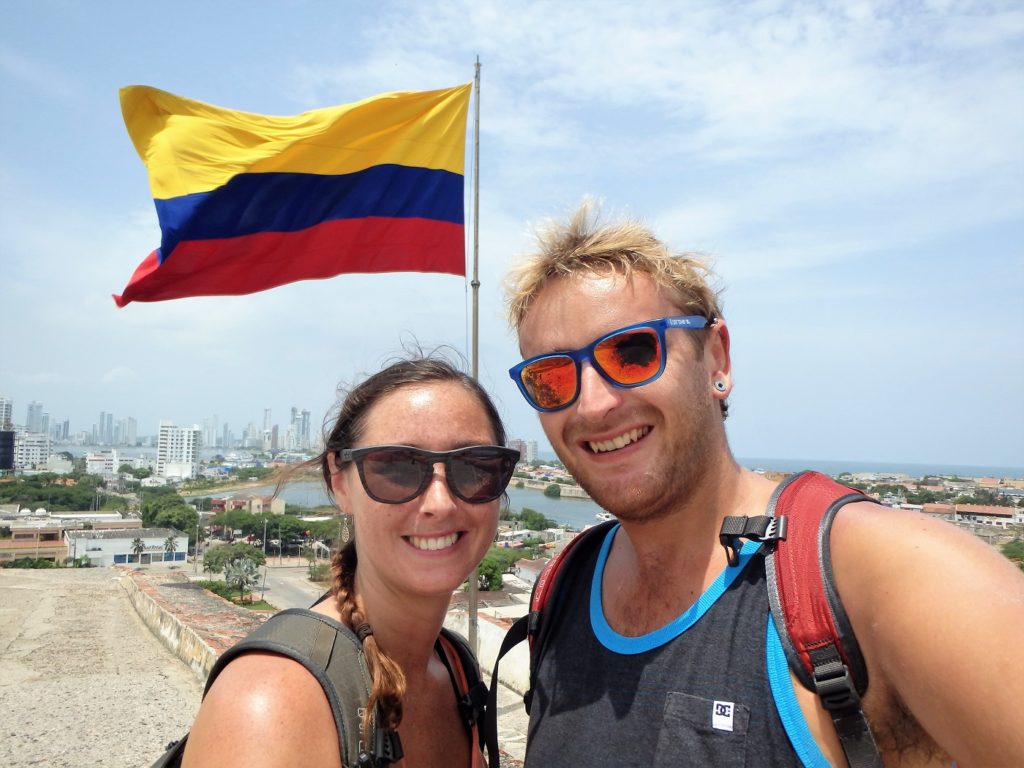
What to do
Backpacking or not, we believe the best place to start in any city is with a free walking tour.
Free Walking Tour
They are just a great way to get a feel for a place and within budget! Plus you can get to grips with your bearings and learn some insider info you may not get from a standard travel guide.
Our tour began at 10am from Plaza Santa Theresa within Las Murallas, the walled Old Town. Over 2 hours we learnt how the Spanish port was developed, its battle for independence as well as its history surrounding slavery and the local women that carry fruit around town
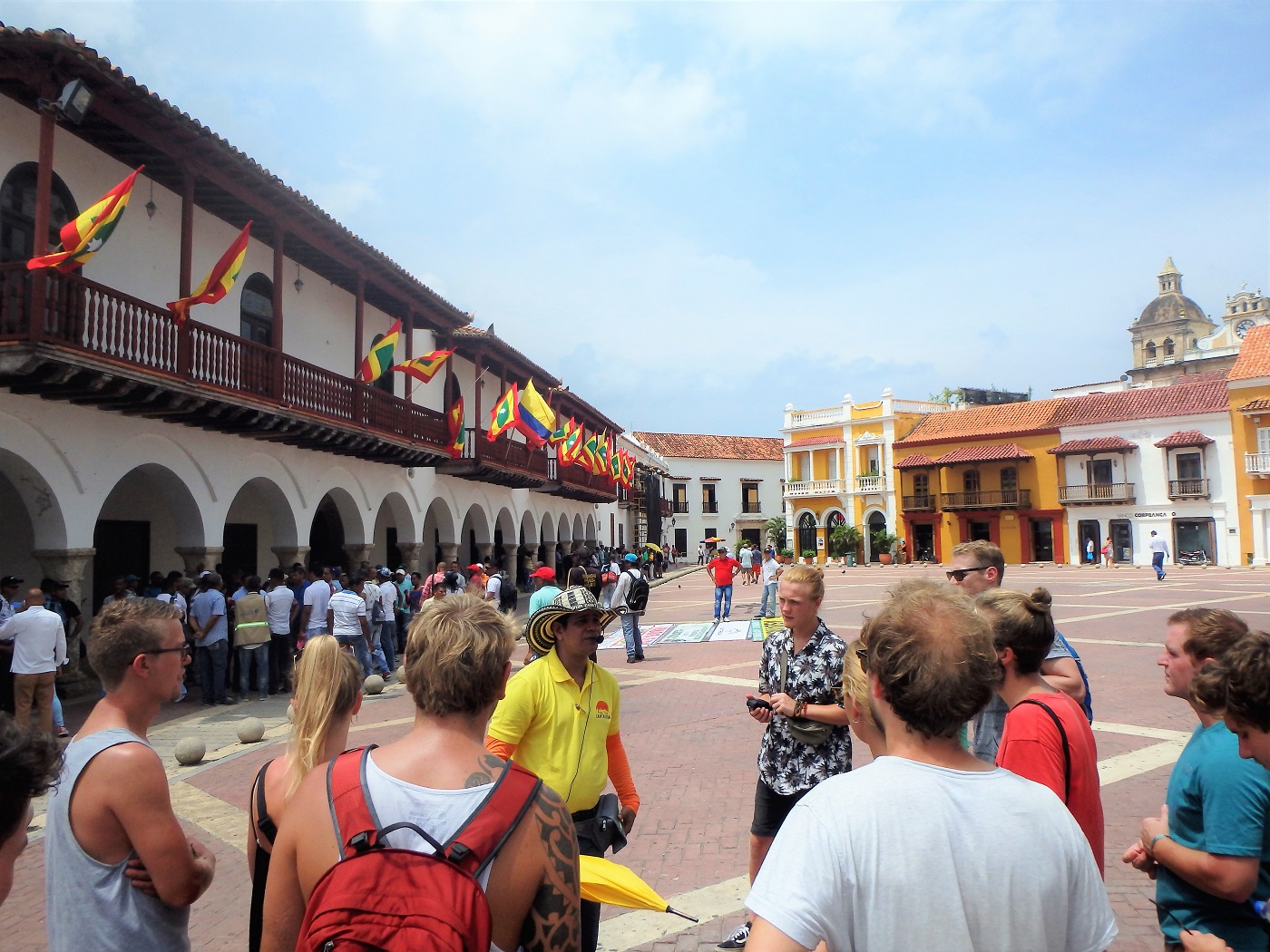
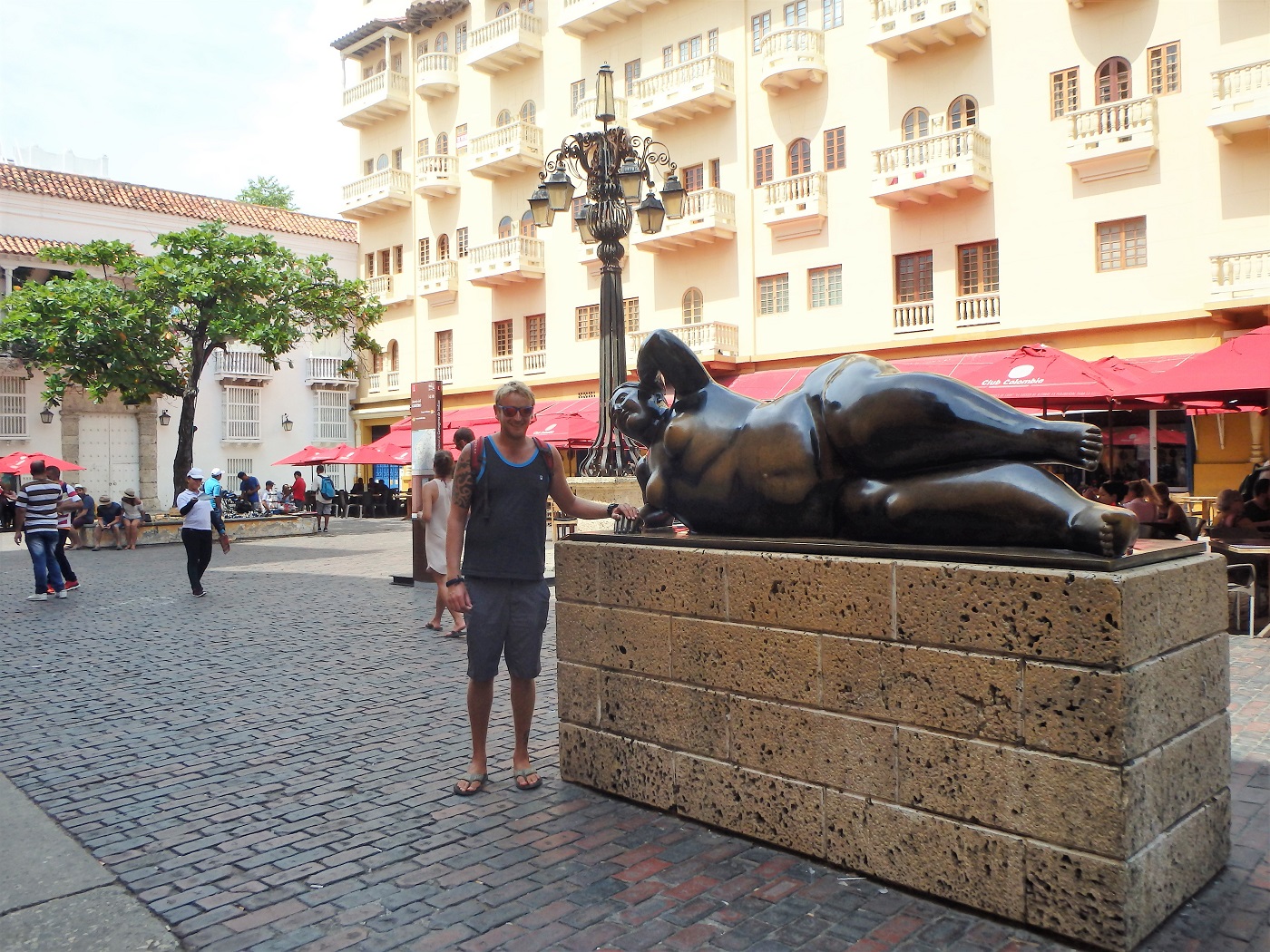
Wander the Old Town
Most travel guides you read on the Old Town will tell you the best way to get acquainted is to simply get lost. Not one to shun good advice, that’s exactly what we did!
The narrow cobblestone streets are such a joy to explore, surrounded by colonial architecture and vibrantly painted buildings adorned with hanging baskets and flowers.
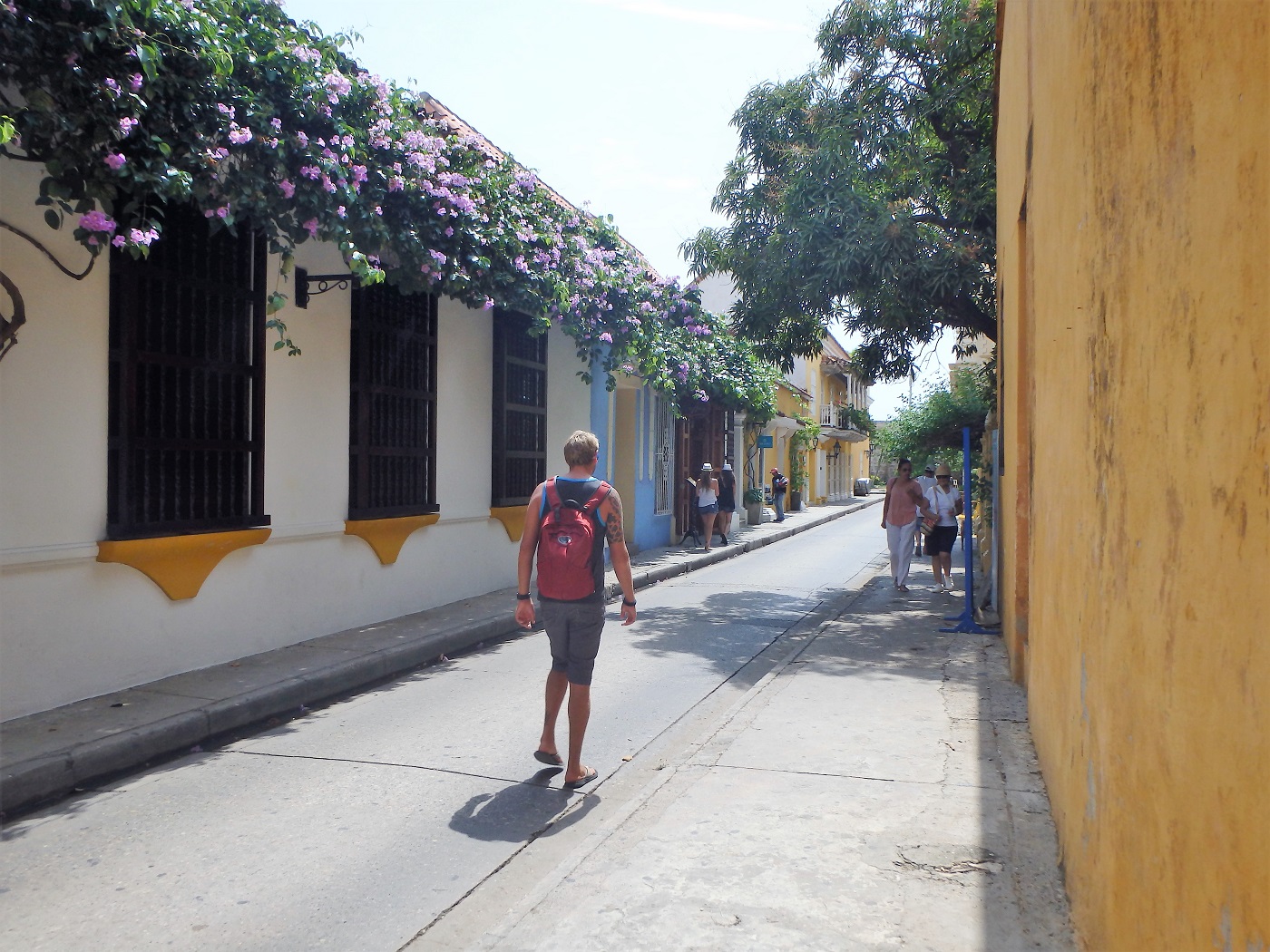
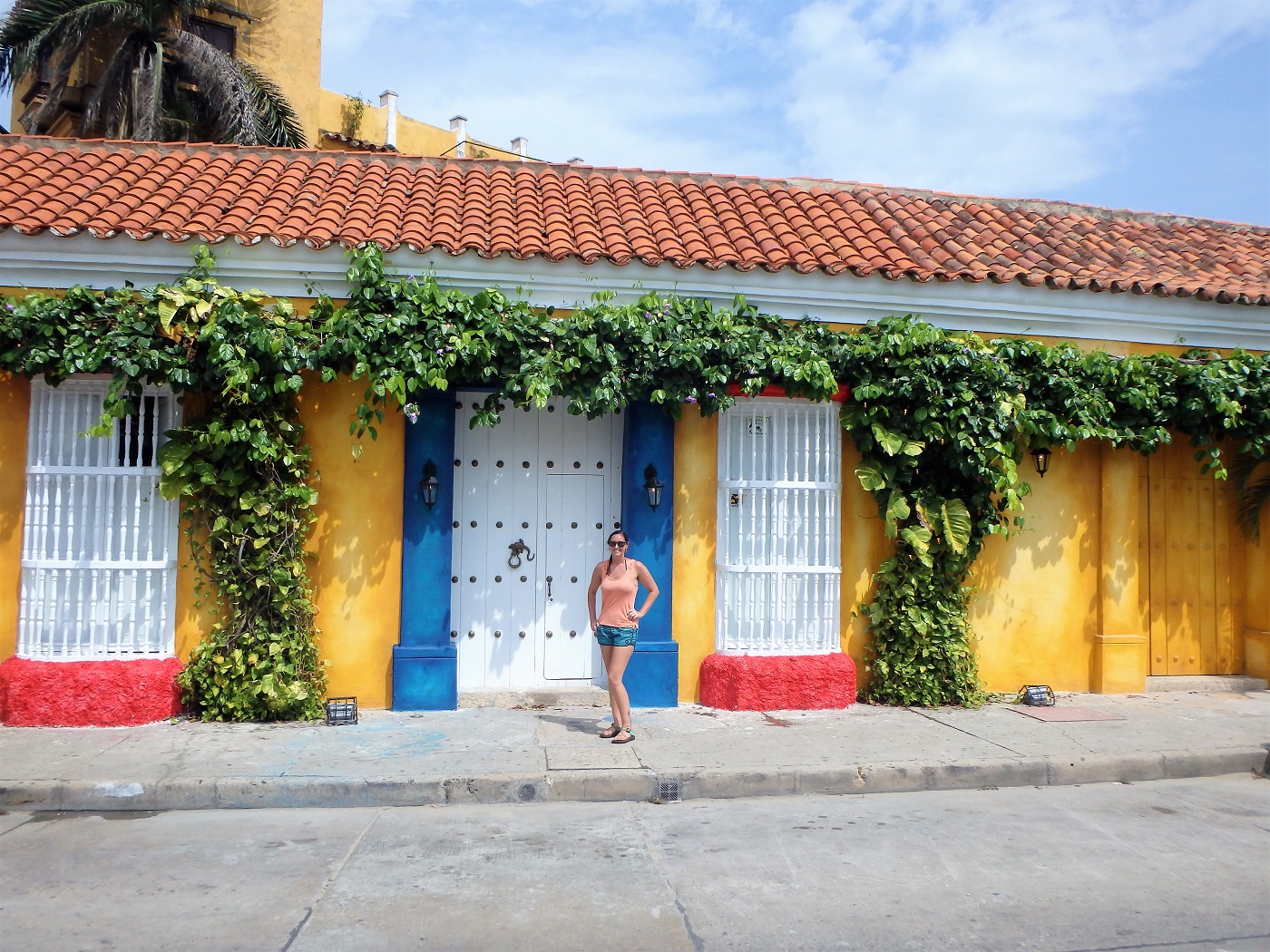
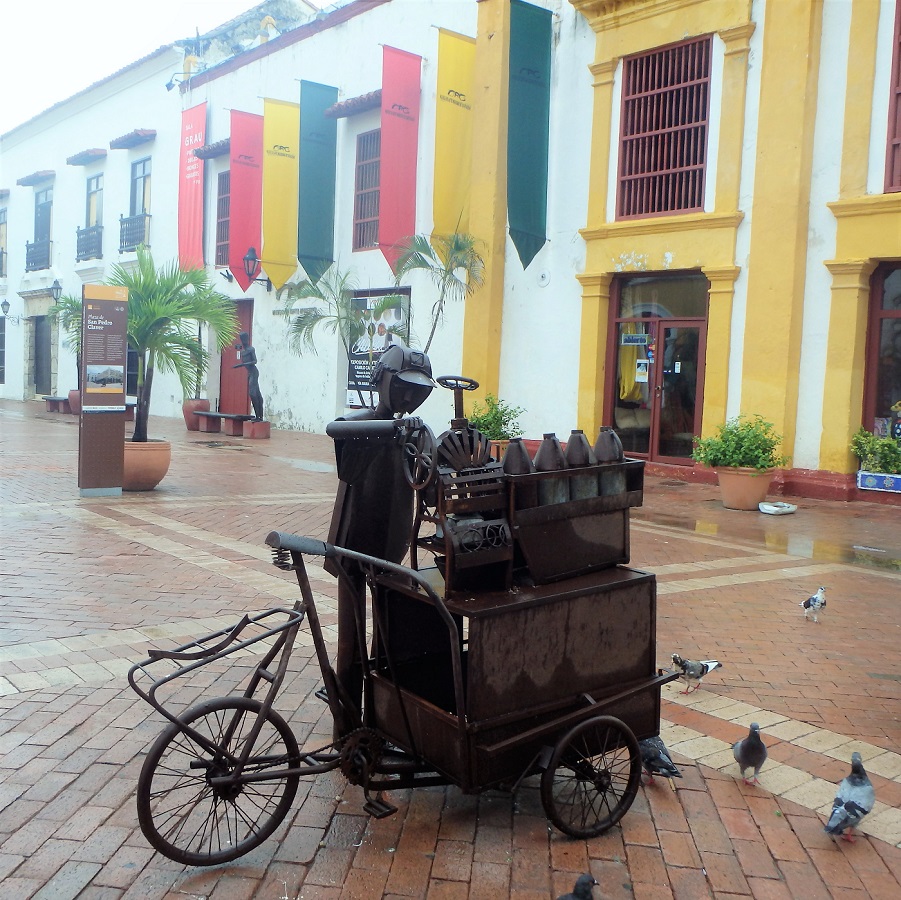
You can also walk along the tops of the walls which offer some fantastic views of the surrounding city. To break up the walking, there are plenty of bars, restaurants, shops and museums.
It doesn’t take much for us to feel like we have earned a beer. Especially when you find a cheap bar and a beer is just $2 each…
As you may expect, being a favourite spot for tourists also means a favourite hangout for hagglers. Everyone wants you to eat at their restaurant or drink at their bar. Not to mention those selling hats, hammocks and anything in between!
We found everyone to be very friendly and so never felt intimidated. We also got advised that if someone persists, you just politely tell them “no, gracias” or even “ya tengo” (I already have).
Visit local landmarks
There are some key landmarks around the town that we made sure to check off the sight-seeing list. These included the Torre del Reloj (Clock Tower Monument), Plaza Santa Domingo, Plaza de Bolivar, Plaza de San Pedro Claver and La India Catalina (just outside the Old Town).
Tip: If you have the opportunity, visit Plaza de Bolivar in the evening from about 6pm when the small park comes alive as local dancers dressed in vibrant outfits put on an impressive show!
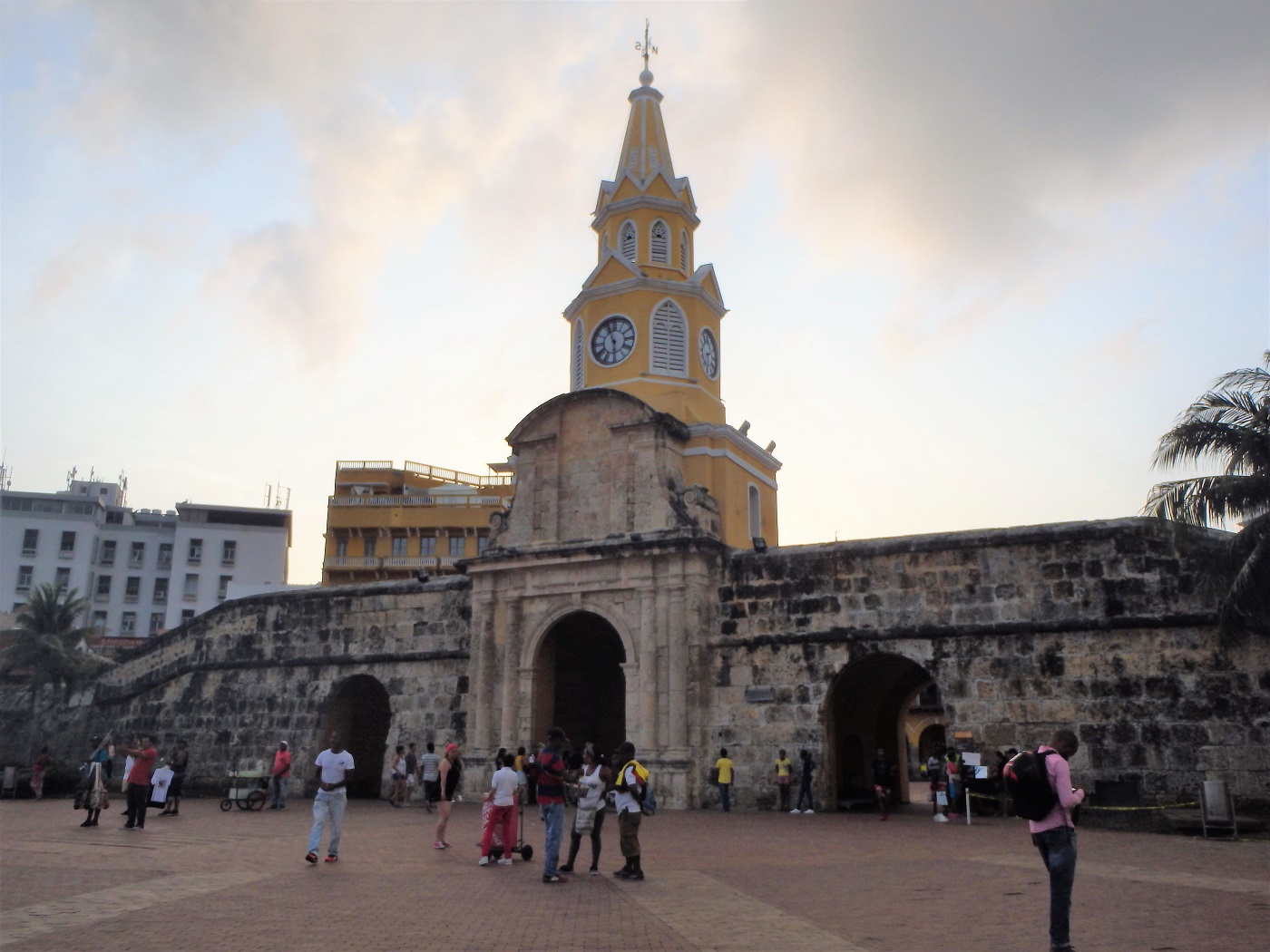
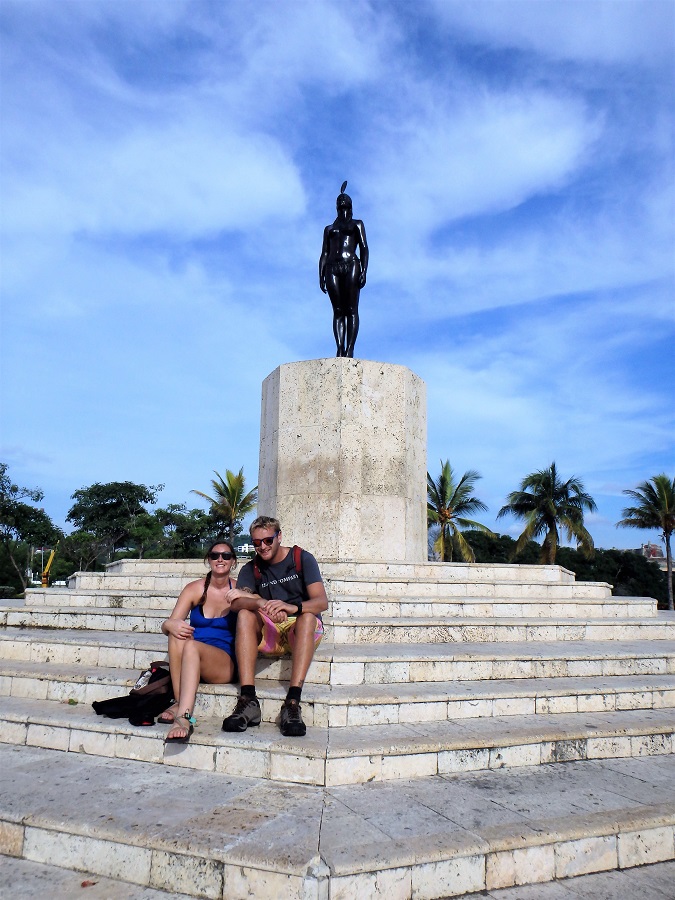
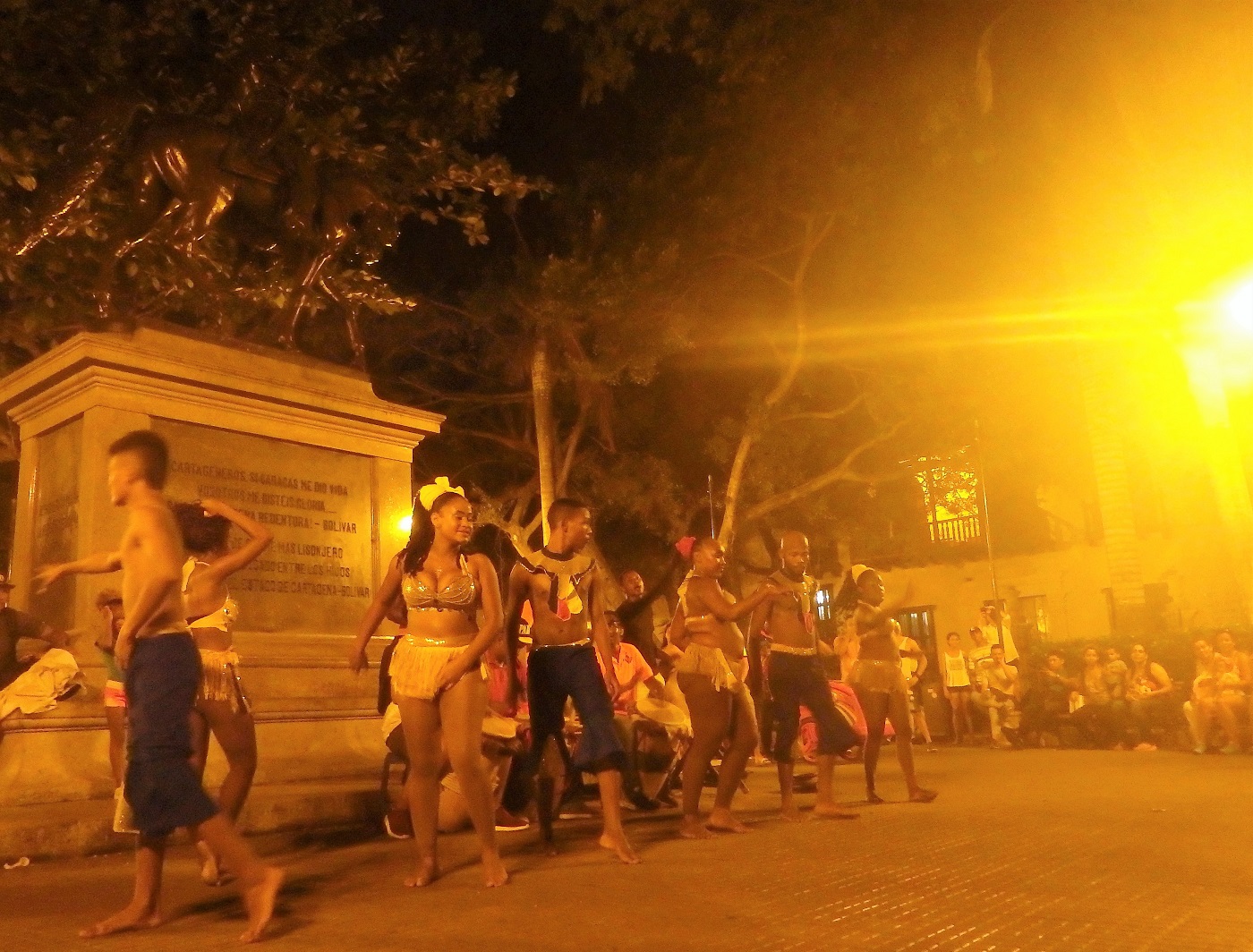
Getsami
We also did a bit more walking just outside the Old Town and around the neighbourhood of Getsami. In the not-too-distant past this area apparently had a bit of a seedy reputation being Cartagena’s red light district.
Now, however, it has shaken this image and is recognised as an up-and-coming hipster district. Boasting restaurants, coffee shops and plenty of amazing street art to admire, it’s is fast becoming a favourite among backpackers.
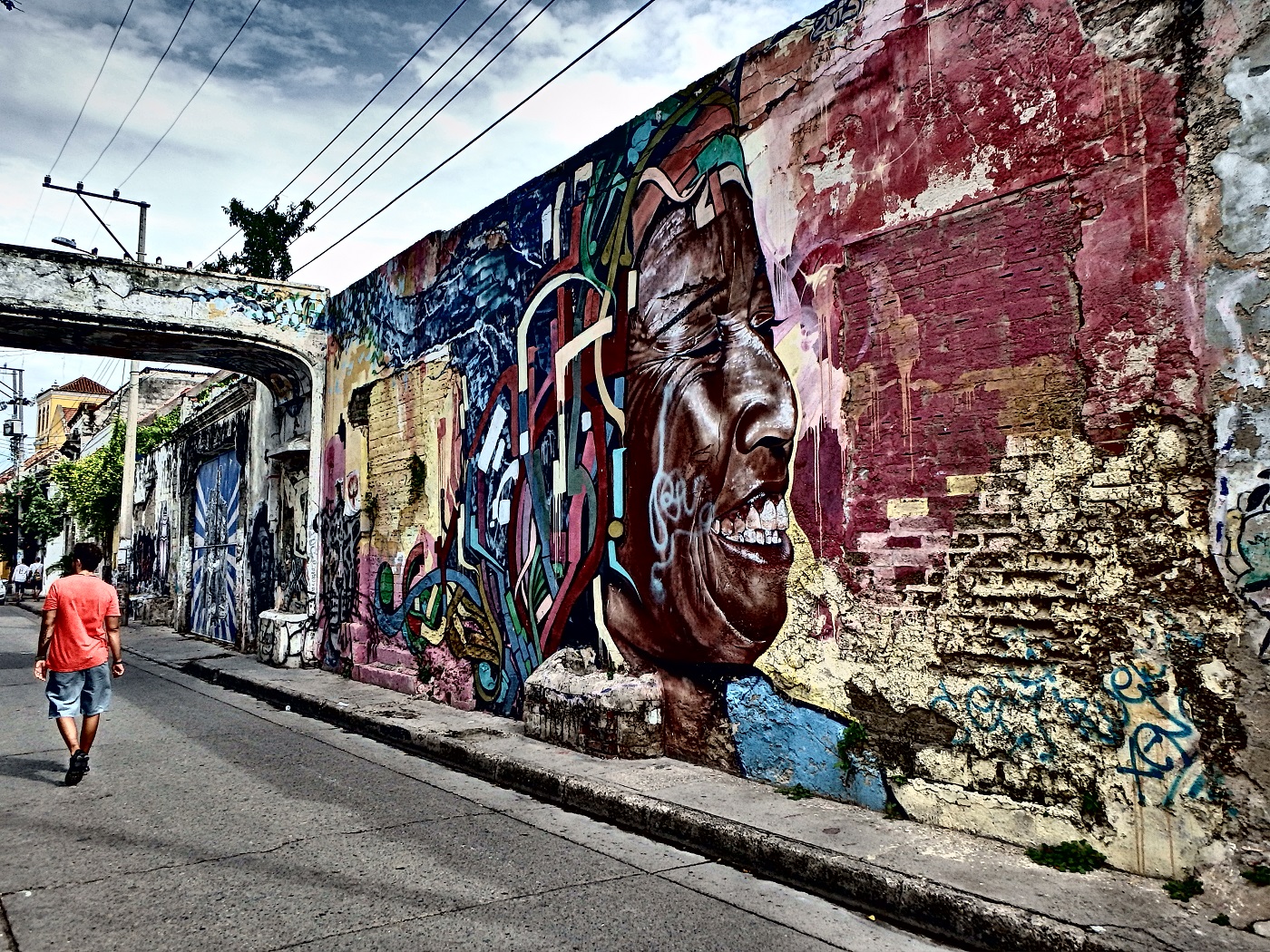
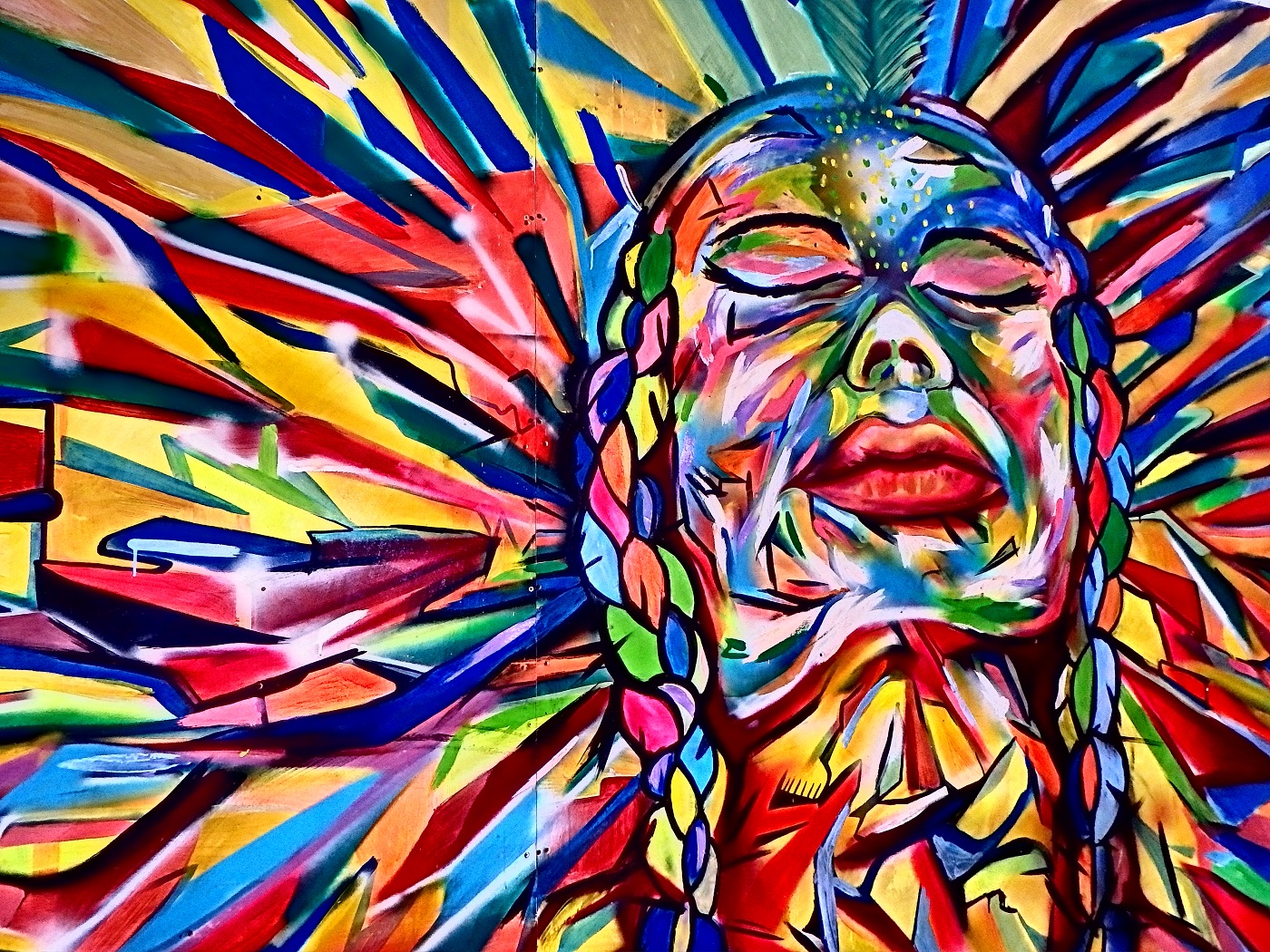
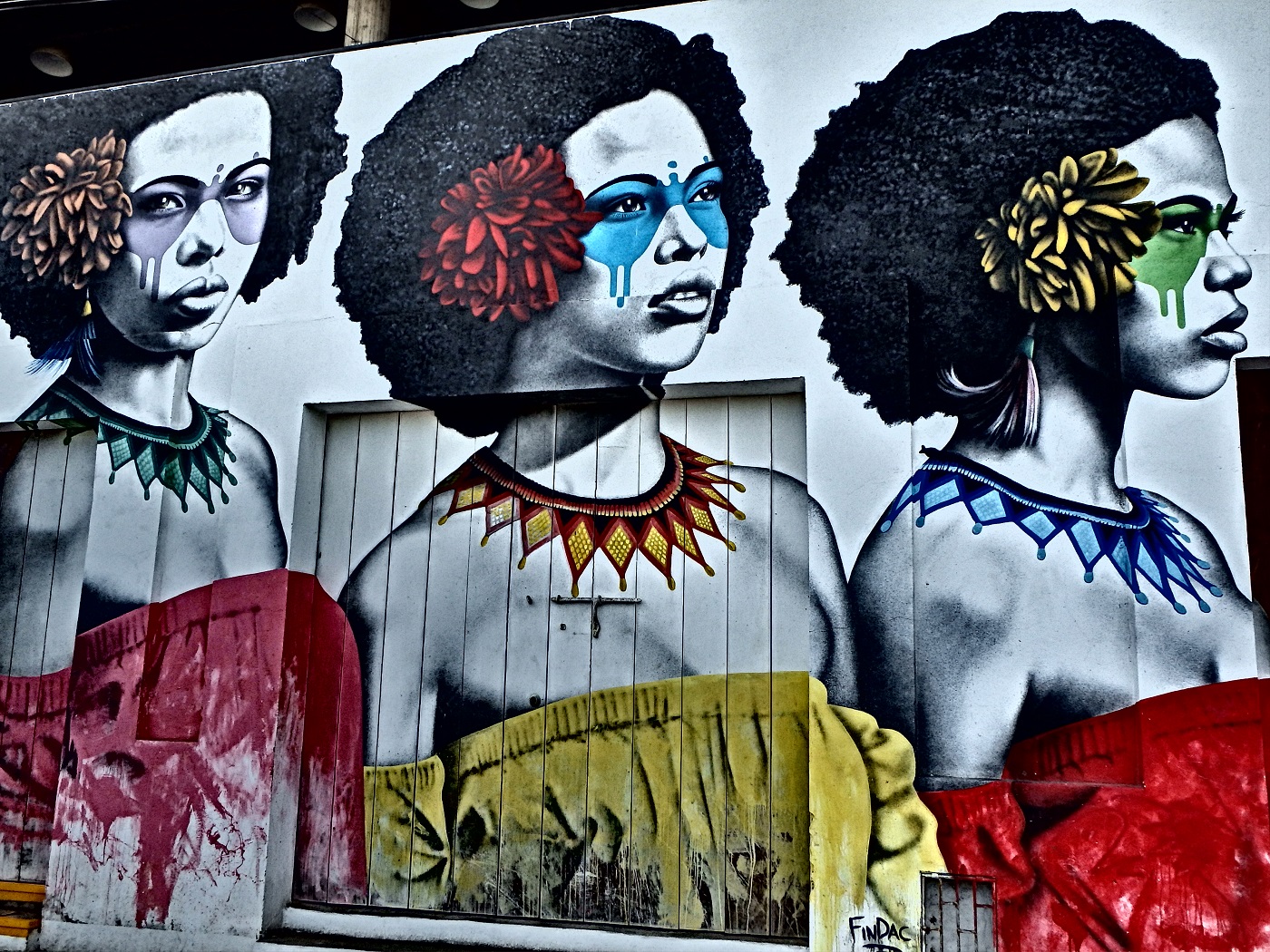
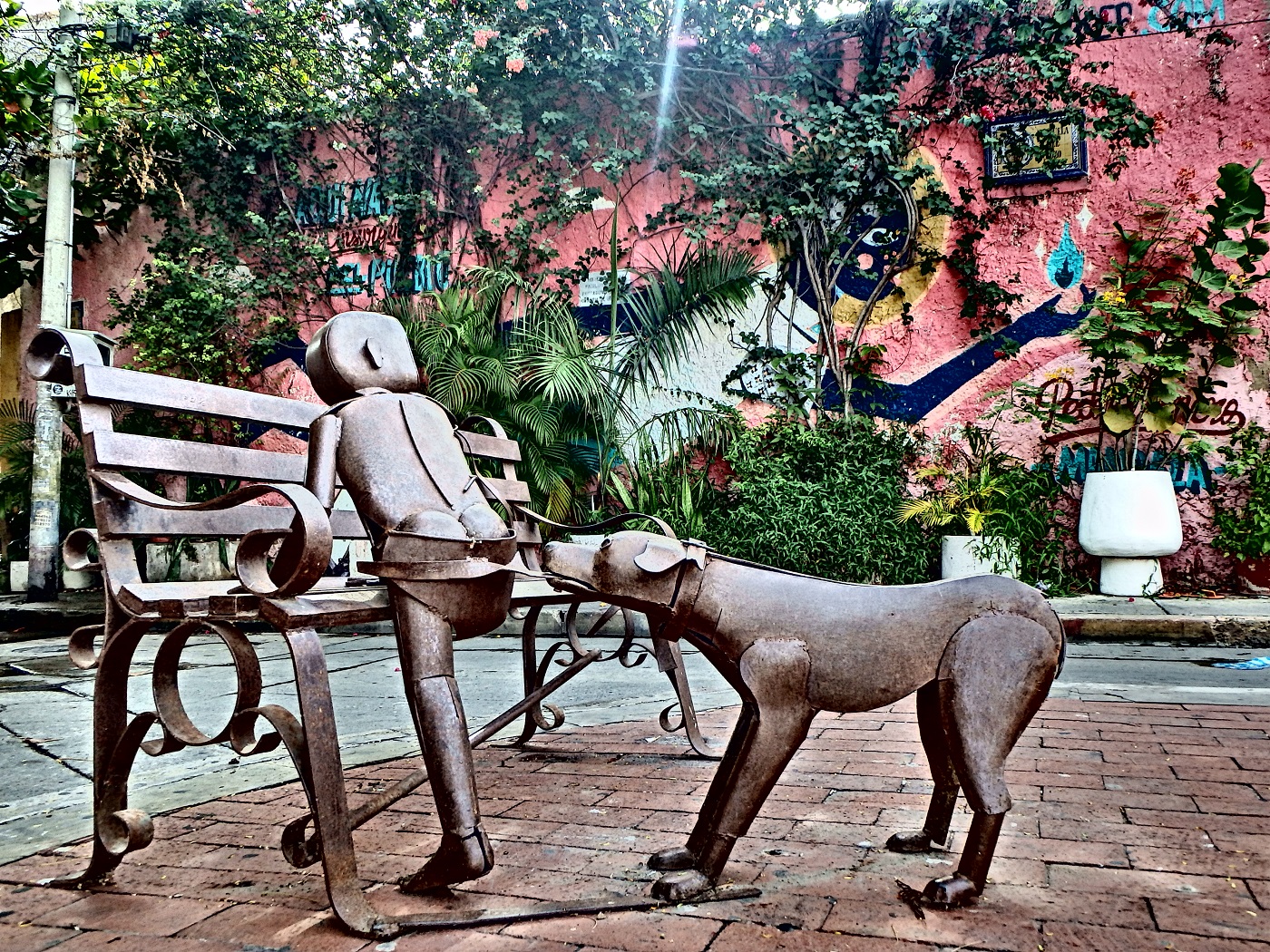
Castillo de San Felipe de Barajas
The Castillo de San Felipe de Barajas was another sight well worth adding to the itinerary. It is cited as the greatest fortress ever built by the Spanish! This impressive structure offers plenty of inner tunnels to explore as well as panoramic views of the city from the outer walls.
Tip: We had read that it was free to visit the fortress on last Sunday of every month. Upon arrival we discovered that this is only true for Colombians and so paid full price on the busiest day of the month. We still enjoyed but recommend avoiding this situation if possible.
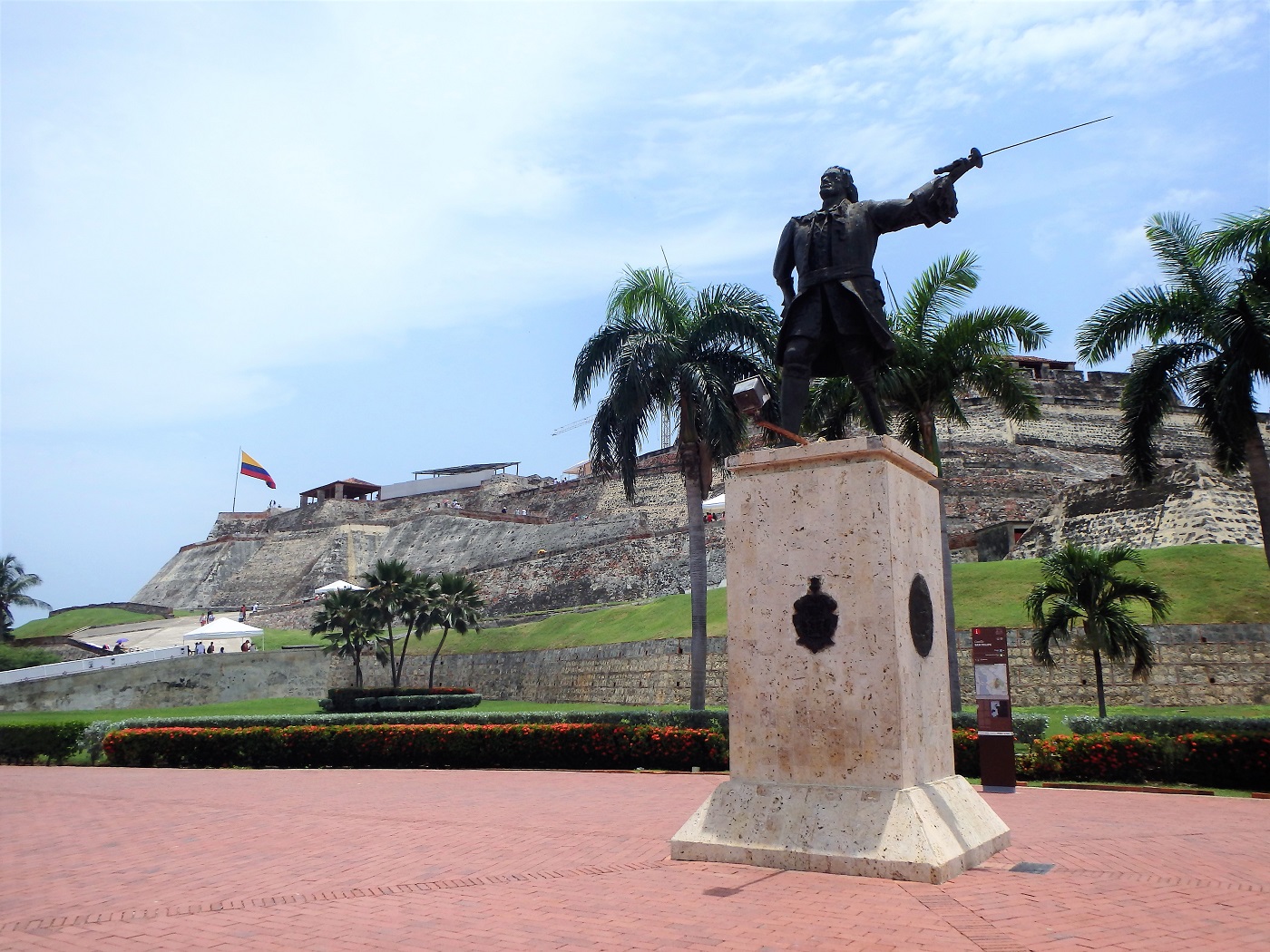
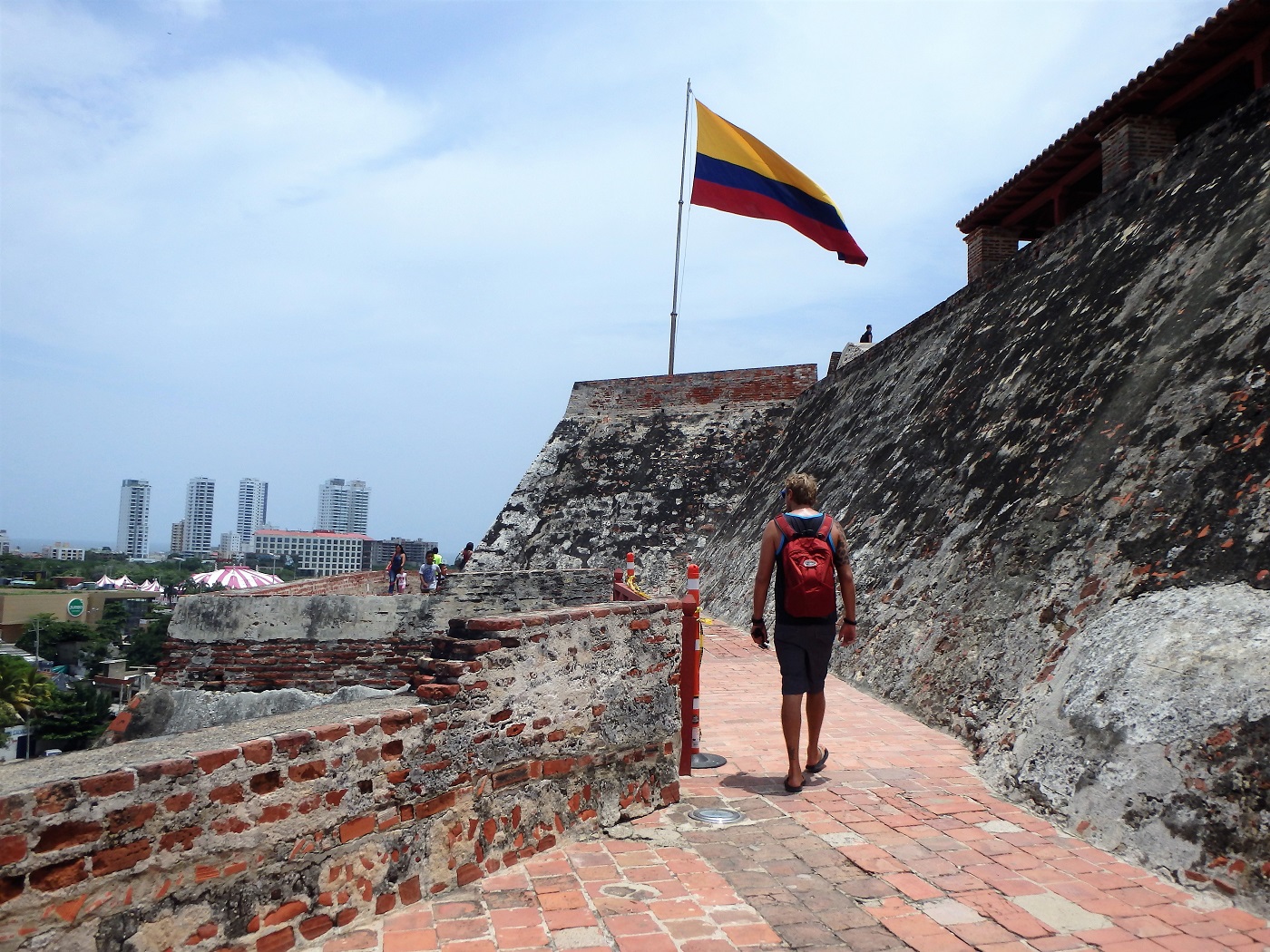
Visit Bocagrande
To explore further afield we rented bikes. Rented within the Old Town we cycled along the waterfront into the upscale district of Bocagrande.
While you are unlikely to find much here on a backpackers budget, it is a beautiful ride and a good break from walking.
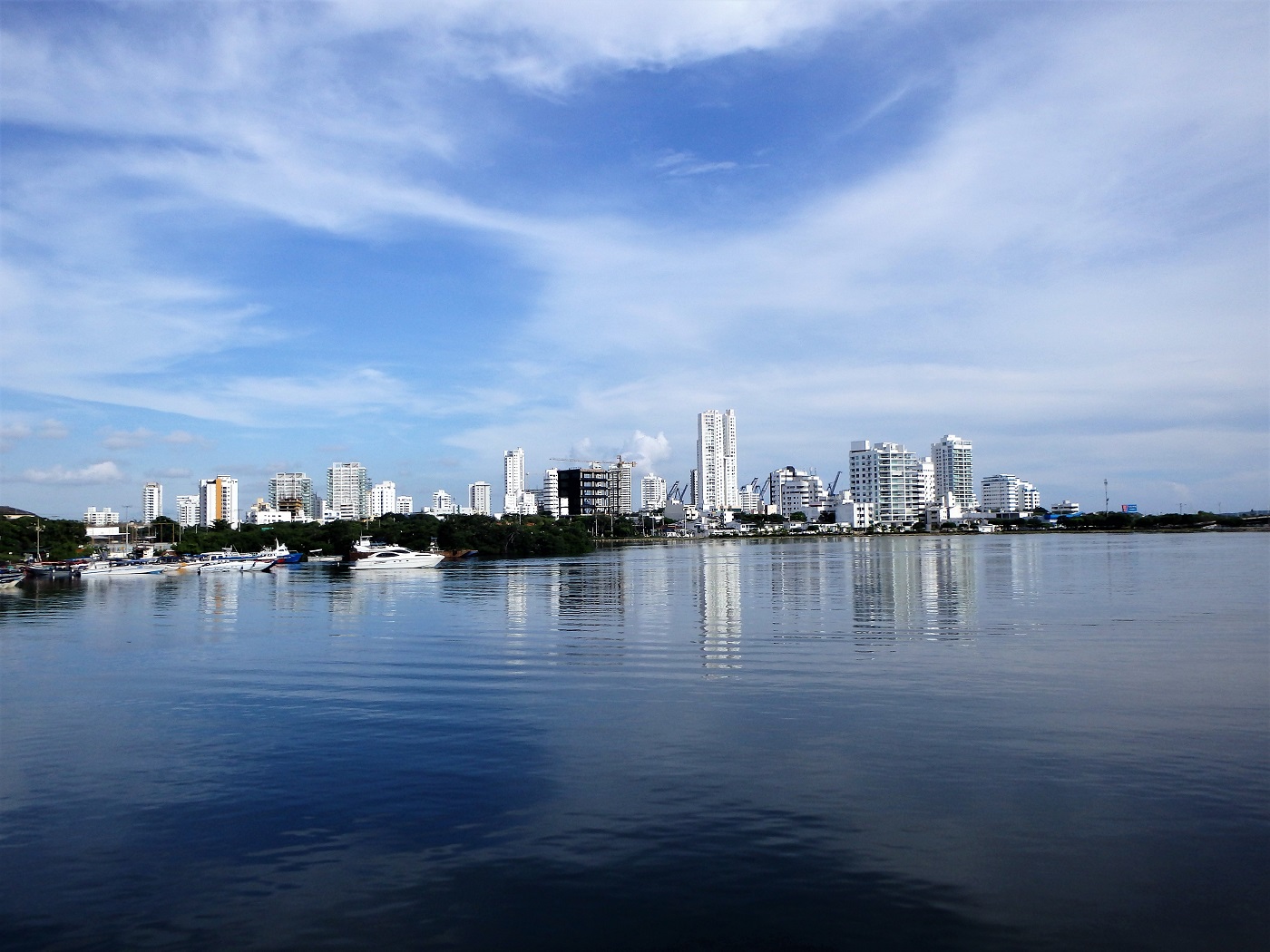
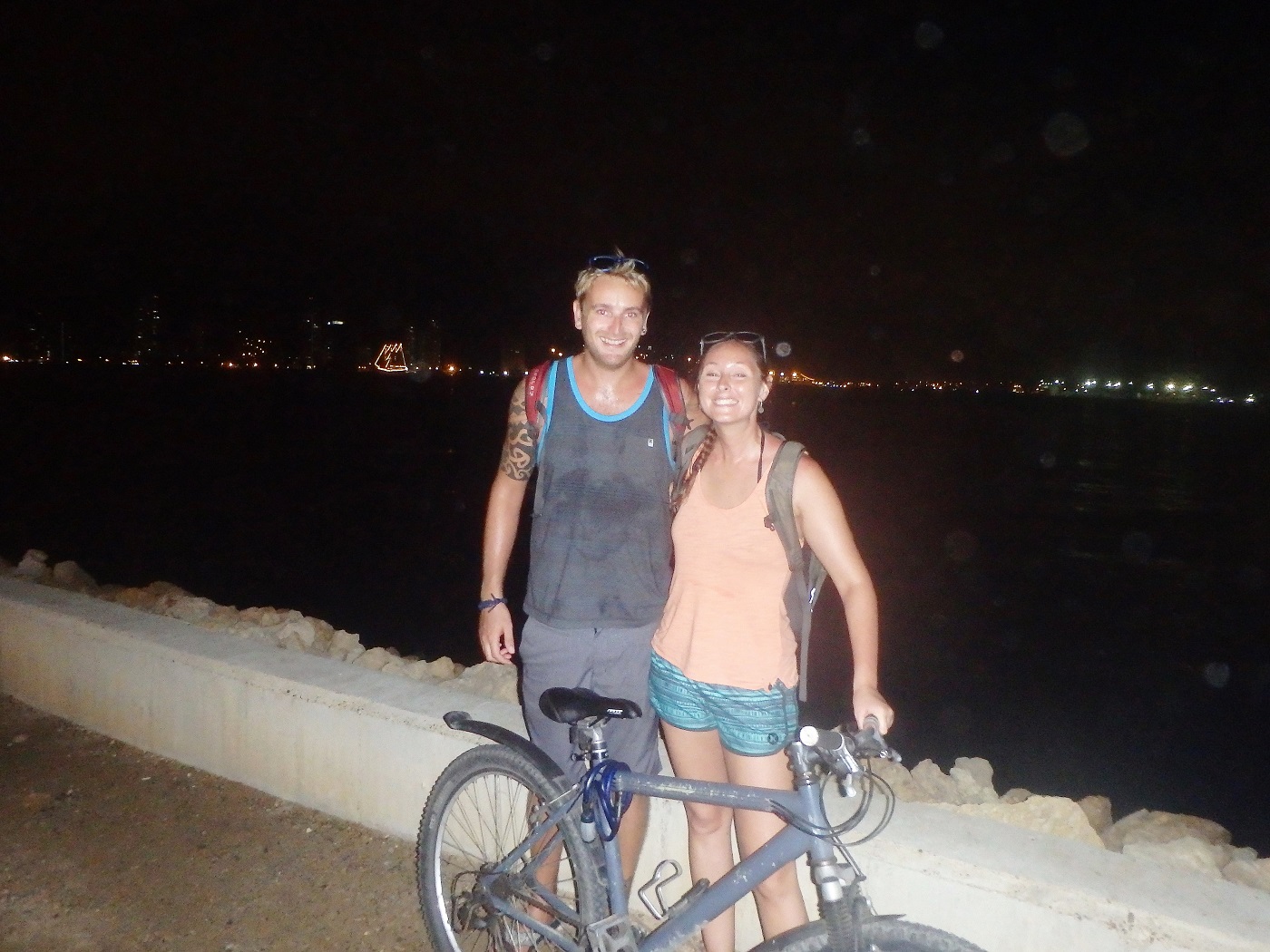
Insider info: Our friend from Cartagena advised us that the city’s neighbourhoods were made up of different ‘levels’. The affluent district of Bocagrande, for example, is a level 5 which is why the cost of living there is much higher. While the cost of places goes down with lower levels, it generally means the level of safety does too.
What to eat
Colombia may not offer the most globally-recognised cuisine but we are always excited about the prospect of trying new, local food! Cartagena did not disappoint.
We were very fortunate to stay with a friend in Cartagena who loves his food as much as we do. Therefore we were spoiled with a personalised food tour highlighting the gastronomic delights of the city. Right up our street!
Street food
Mazorca des Granada, our first proper meal in Colombia (although technically a snack), is definitely one to try. I am not a huge sweetcorn fan, but this steaming pile of hot corn smothered in garlic sauce (salsa de ajo) is mouth-wateringly delicious! Not to mention cheap.
While corn is certainly a staple in Colombia (and indeed most of South America) there is another contender that may take the crown: bread. Colombians love their bread! Not to mention their cheese.
There are countless bakeries offering a variety of baked goods:
- Pandebono – a soft, moreish cheese bread
- Arepas – a corn-based bread typically stuffed with cheese
- Empanadas – a South American-style pasty filled with meat, vegetables or, shockingly, cheese! My absolute favourite.
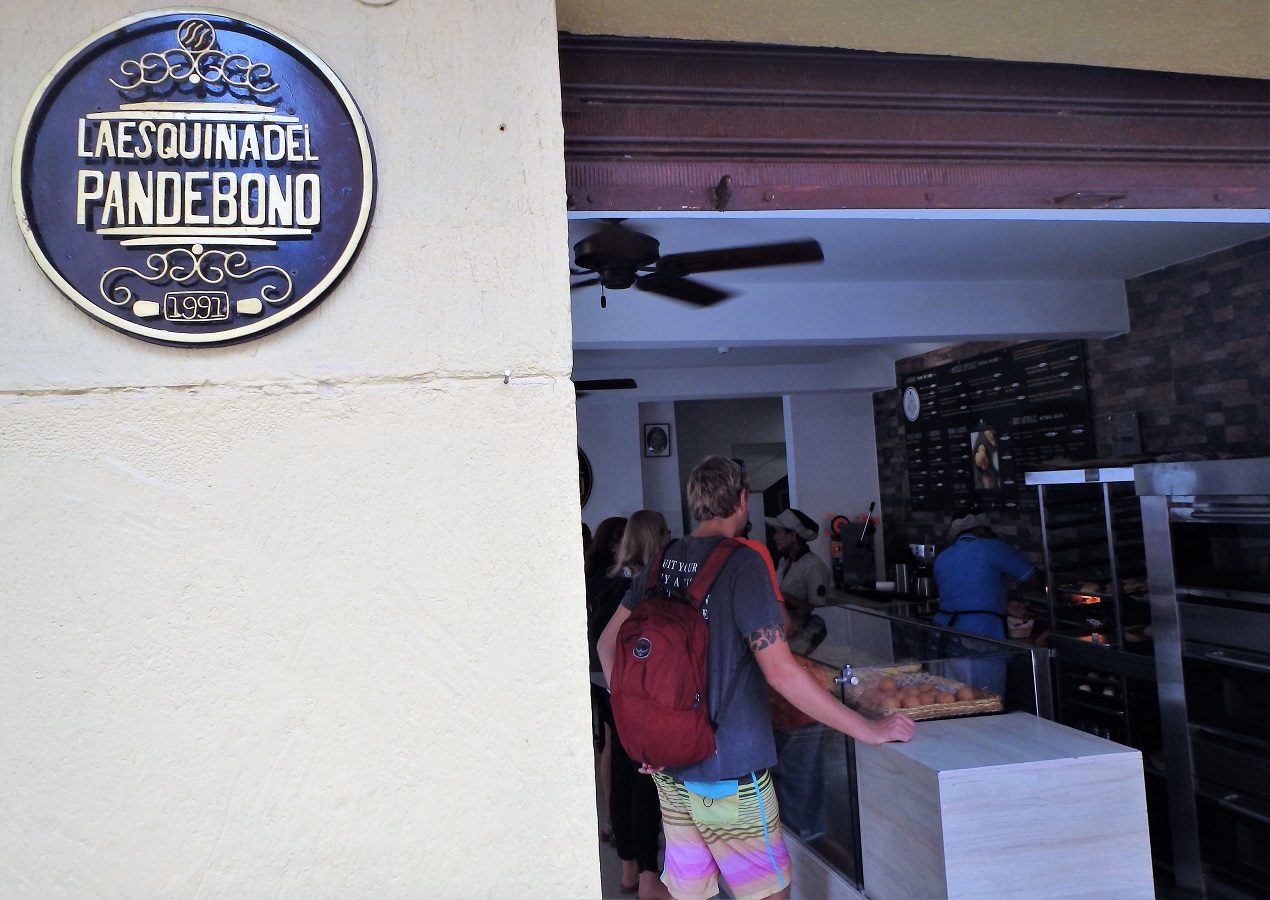
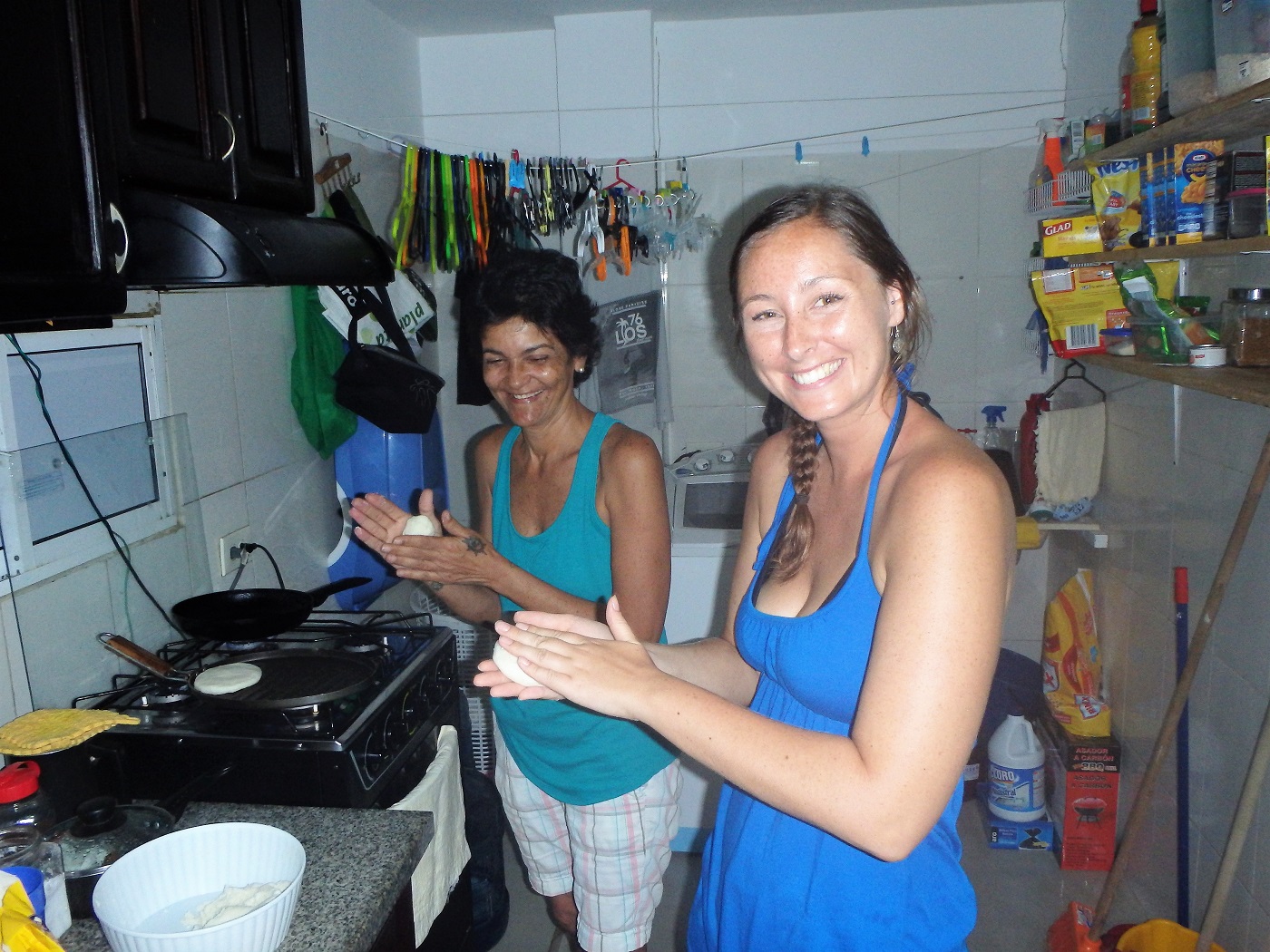
Lunch
When it comes to lunch you cannot beat the budget-friendly almuerzo menu del dia (lunch menu of the day) costing just US$4-$6.
It typically includes a bowl of soup (meat or veggie broth) paired with a generous main of pollo (chicken) or carne (beef) along with rice, beans, salad and quite often chips. Super filling and always a win when backpacking on a tight budget!
With Cartagena being on the coast, they typically serve more fish on their menus. Our friend Jorge took us to a well known local restaurant, La Mulata, which we definitely recommend for seafood.
Here we enjoyed sopa de pescado (fish soup) with a mountainous main of fish topped with clams, conch, octopus, squid and prawns! Even the sides of coconut rice, avocado salad and patacones (crispy deep-fried plantain) were phenomenal. Even more shocking was this seemingly indulgent lunch cost just $6!!
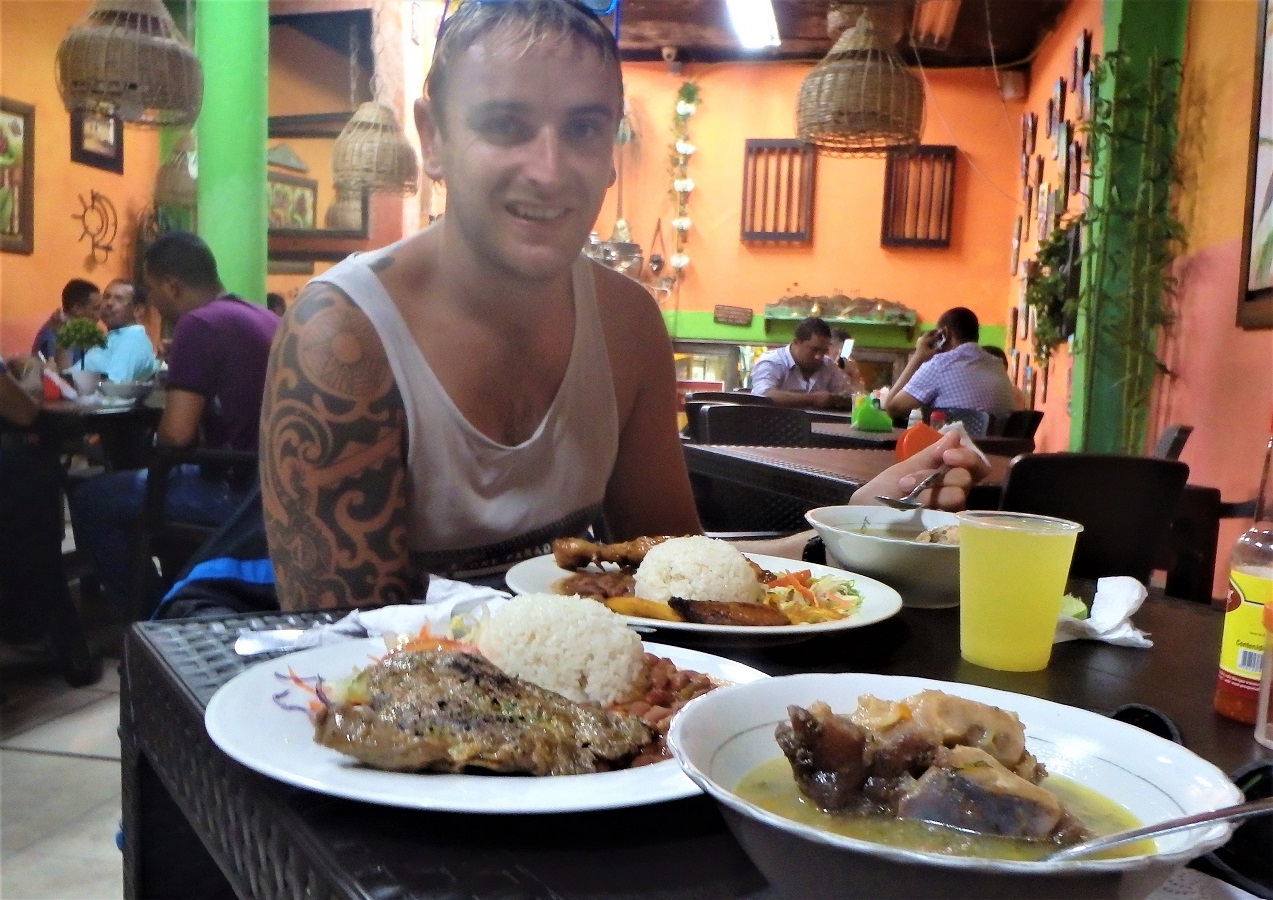
A few other notable mentions that have to be included. Firstly, the refreshing jugo (juice) stands which are very popular in this part of the world. A variety of exotic fruits such as papaya, passion fruit and lulo are blended con leche (with milk) or con agua (with water).
If you prefer water like us, try and ask for bottled water to stay on the safe side.
Another quite unique street food we tried I can only describe as ‘mango fries’. Except they aren’t fried…
An unripened mango is cut into thin strips and served with a dusting of salt and squeeze of lime for a savoury snack. Rhys was a fan but I have to admit it wasn’t for me.
Lastly, you have to check out what I call ‘sweetshop alley’ (opposite the clock tower within the walled town). Here you will find the most enticing variety of sweet treats on offer – make sure you try the cocadas blancas, a delicious morsel of sugared, shredded coconut. Yum!
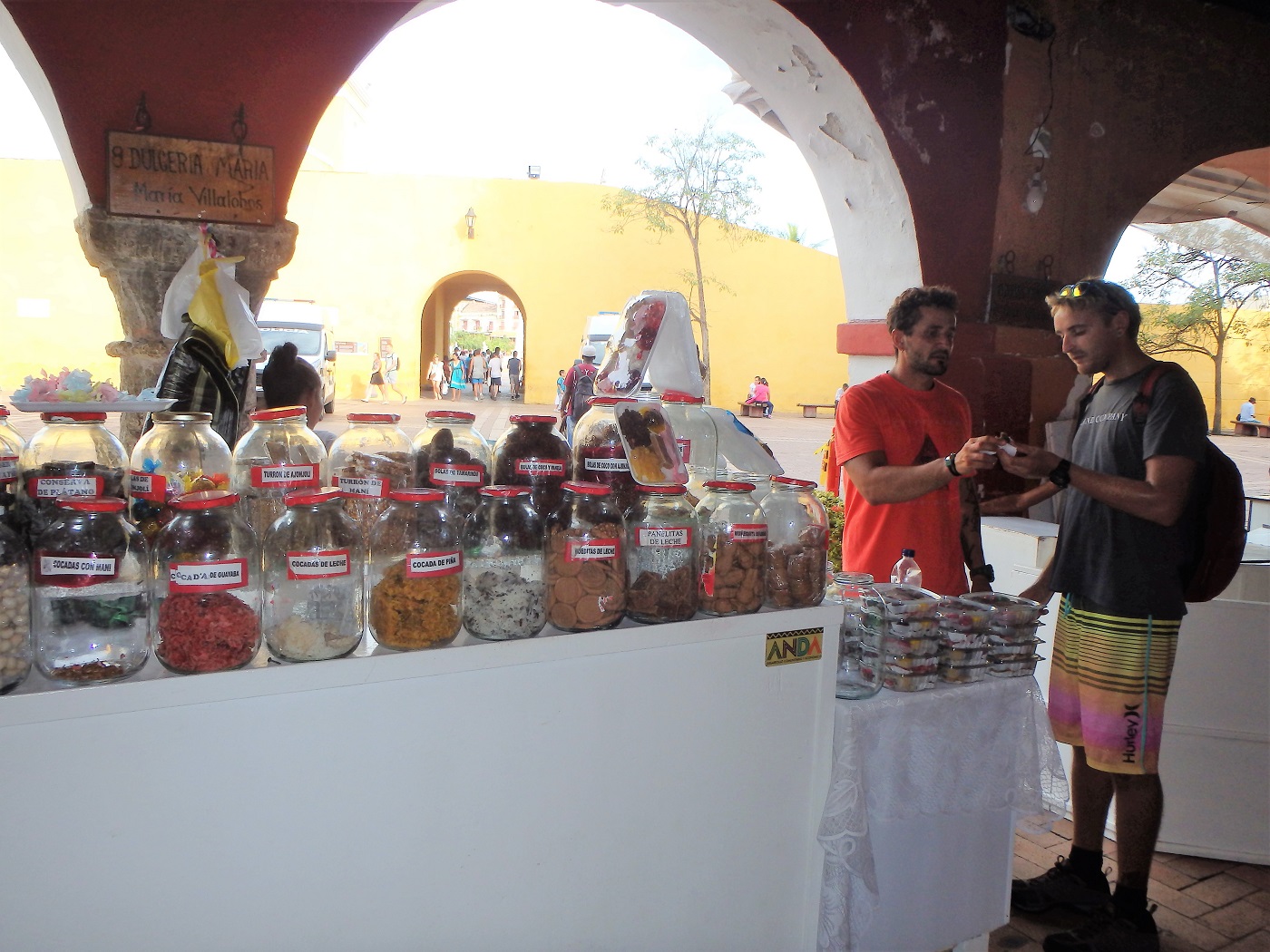
Where to stay
Being lucky to have a generous friend welcome us into his family home, we stayed in the residential district of Crespo. This is around a 5 minute taxi ride from the Old Town. Had it not been for Jorge’s generosity, we would have stayed either within the Old Town itself or in Getsami.
To book accommodation, we relied mostly on Hostelworld when backpacking through South America. It was usually the best way to find budget-friendly options.
In general, you don’t really want to be spending more than US$10-12 per night in Colombia. Therefore we would recommend checking out Hostel La Antigua Capsula or Makako Chill Out Hostel.
If you have a bit more leniency with your budget, then spend a bit more at The Clock Hostel and Suites or Republica Hostel.
Getting there
Many backpackers we met in Colombia arrived via Bogota or Medellín. We instead flew direct to Cartagena from Miami. Our fairly brief 2.5hr flight cost us around US$200 each.
The benefit of beginning on the north coast and heading south is eliminating the time and expense of doubling back on yourself. We did however meet many backpackers doing just this.
An alternative method we were advised of (unfortunately after booking our flights) is sailing to Cartagena through San Blas from Panama! Definitely something to check out, especially if you’re coming from Central America.
We hope that any fellow backpacker’s reading this will be as excited to visit Cartagena as we were! It is a truly a vibrant, exciting city with lots to be explored, on a budget. Happy travels!
